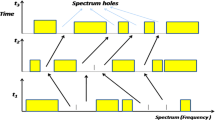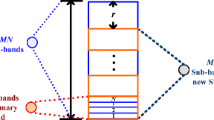Abstract
In cognitive radio networks (CRNs), spectrum handoff probability and expected number of spectrum handoffs are important parameters in the evaluation of network performance and design. This paper presents an analytical model for spectrum handoff probability and spectrum handoff rate for CRNs under general distribution of call holding time of secondary users (SUs). The standardized analytical forms of spectrum handoff probability and handoff rate of secondary network under negotiated scenario are derived for a complete service call duration. The effect of mobility parameters: departure rate of SUs (\(\upmu )\) and departure rate of spectrum holes (\(\uplambda )\) on spectrum handoff are also reported in this paper. Extensive results for all the proposed analytical models are obtained and presented in this paper. Analytical results show that exponential and Erlangian distribution functions are not suitable for call holding time of SU in the analysis of spectrum handoff in CRNs. Moreover, the superiority of lognormal distribution function ascertains its use for call holding time of SU in spectrum handoff estimation for better CRN performances. The Monte-Carlo simulation is also performed for spectrum handoff probability to validate the analytical model.










Similar content being viewed by others
References
Mitola, J., & Maguire, G. Q. (1999). Cognitive radio: Making software radios more personal. IEEE Personal Communication Mag, 6(4), 13–18.
Haykin, S. (2005). Cognitive radio: Brain-empowered wireless communications. IEEE Journal on Selected Areas in Communications, 23, 201–220.
Akyildiz, F., Lee, W.-Y. W., Vuran, M. C., & Mohanty, S. (2006). Next generation/dynamic spectrum access/cognitive radio wireless networks: A survey. Computer Networks, 50(13), 2127–2159.
Jondral, F. K. (2005). Software-defined radio-basics and evolution to cognitive radio. EURASIP Journal on Wireless Communications and Networking, 3, 275–283.
Akyildiz, I. F., Lee, W.-Y., Vuran, M. C., & Mohanty, S. (2008). A survey on spectrum management in cognitive radio networks. IEEE Communications Magazine, 46(4), 40–48.
Christian, I., Moh, S., Chung, I., & Lee, J. (2012). Spectrum mobility in cognitive radio networks. IEEE Communications Magazine, 50(6), 114–121.
Wang, L. C., Wang, C. W., & Chang, C. J. (2012). Optimal target channel sequence design for multiple spectrum handoffs in cognitive radio networks. IEEE Transactions on Communications, 60(9), 2444–2455.
Wang, L. C., Wang, C. W., & Chang, C. J. (2012). Modeling and analysis for spectrum handoffs in cognitive radio networks. IEEE Transactions on Mobile Computing, 11(9), 1499–1513.
Hong, D., & Rappaport, S. S. (1986). Traffic model and performance analysis for cellular mobile radio telephone systems with prioritized and non-prioritized handoff procedures. IEEE Transactions on Vehicular Technology, 35(3), 77–92.
Tekinay, S., & Jabbari, B. (1991). Handover and channel assignment in mobile cellular networks. IEEE Communications Magazine, 29(11), 42–46.
Lin, Y. B., Mohan, S., & Noerpel, A. (1994). Queuing priority channel assignment strategies for handoff and initial access for a PCS network. IEEE Transactions on Vehicular Technology, 43(3), 704–712.
Yum, T. S., & Yeung, K. L. (1995). Blocking and handoff performance analysis of directed retry in cellular mobile systems. IEEE Transactions on Vehicular Technology, 44(3), 645–650.
Del Re, E., Fantacci, R., & Giambene, G. (1995). Handover and dynamic channel allocation techniques in mobile cellular networks. IEEE Transaction on Vehicular Technology, 44(2), 229–237.
Bolotin, V. A. (1994). Modeling call holding time distributions for CCS network design and performance analysis. IEEE Journal on Selected Areas in Communications, 12(3), 433–438.
Orlik, P. V., & Rappaport, S. (1998). A model for tele-traffic performance and channel holding time characterization in wireless cellular communication with general session and dwell time distributions. IEEE Journal on Selected Areas in Communications, 16(5), 788–803.
Barcelo, F., & Jordan, J. (1999). Channel holding time distribution in public telephony system. In Proceedings of 16th international tele-traffic congress (pp. 107–116). Elsevier Science.
Barcelo, F., & Jordan, J. (2000). Channel holding time distribution in public telephony system (PAMR and PCS). IEEE Transactions on Vehicular Technology, 49(5), 1615–1625.
Pattavina, A., & Parini, A. (2005). Modelling voice call interarrival and holding time distributions in mobile networks. In Proceedings of the 19th International Teletraffic Congress (ITC’05) (pp. 729–738).
Fang, Y., Chlamtac, I., & Lin, Y. B. (1997). Modeling PCS networks under general call holding time and cell residence time distributions. IEEE/ACM Transactions on Networking, 5(6), 893–906.
Fang, Y., Chlamtac, I., & Lin, Y. B. (1997). Call performance for a PCS network. IEEE Journal on Selected Areas in Communications, 15(8), 1568–1581.
Fang, Y., Chlamtac, I., & Lin, Y. B. (1998). Channel occupancy times and handoff rate for mobile computing and PCS networks. IEEE Transactions on Computers, 47(6), 679–692.
Fang, Y., & Chlamtac, I. (2002). Analytical generalized results for handoff probability in wireless networks. IEEE Transactions on Communications, 50(3), 396–399.
Fang, Y. (2005). Modeling and performance analysis for wireless mobile networks: A new analytical approach. IEEE/ACM Transactions on Networking, 13(5), 989–1002.
Chlebus, E. (1977). Empirical validation of call holding time distribution in cellular communications systems. In Proceedings of the 15th ITC (pp. 1179–1188) June 1977. Washington, DC.
Pattaramalai, S., Aalo, V. A., & Efthymoglou, G. P. (2007). Call completion probability withWeibull distributed call holding time and cell dwell time. In Proceedings of the IEEE GLOBECOM Washington, DC, November 2007 (pp. 2634–2638).
Pattaramalai, S., Aalo, V. A., & Efthymoglou, G. P. (2009). Evaluation of call performance in cellular networks with generalized cell dwell time and call-holding time distributions in the presence of channel fading. IEEE Transactions on Vehicular Technology, 58(6), 3002–3013.
Jedrzycki, C., & Leung, V. C. M. (1996). Probability distribution of channel holding time in cellular telephony systems. In Vehicular Technology Conference, 1996. Mobile Technology for the Human Race, IEEE 46th, Atlanta, GA, 1996 (pp. 247–251).
Tuyatsetseg, B. (2011). Parametric modeling approach for call holding times for IP based public safety networks via EM algorithm. In Proceedings of the global communications conference, GLOBECOM 2011, 5–9 December 2011.
Song, Y., & Xie, J. (2011). Performance analysis of spectrum handoff for cognitive radio ad hoc networks without common control channel under homogeneous primary traffic. In Proceedings of the IEEE INFOCOM.
Zhang, Y. (2009). Spectrum handoff in cognitive radio networks: Opportunistic and negotiated situations. In Proceedings of IEEE ICC 2009, vol. 1, no. 6 (pp. 14–18).
Zhang, H., Jiang, C., Cheng, J., & Leung, V. C. M. (2015). Cooperative interference mitigation and handover management for heterogeneous cloud small cell networks. IEEE Wireless Communications, 22(3), 92–99.
Zhang, H., Jiang, C., Beaulieu, N. C., Chu, X., Wang, X., & Quek, T. Q. S. (2015). Resource allocation for cognitive small cell networks: A cooperative bargaining game theoretic approach. IEEE Transactions on Wireless Communications, 14(6), 3481–3493.
Giupponi, L., Perez-Neira, A. I. (2008). Fuzzy-based spectrum handoff in cognitive radio networks. In: Cognitive radio oriented wireless networks and communications, 2008. CrownCom 2008. 3rd International Conference on, Singapore (pp. 1–6).
Ahmed, E., Yao, L. J., Shiraz, M., Gani, A., & Ali, S. (2013). Fuzzy-based spectrum handoff and channel selection for cognitive radio networks. In Computer, control, informatics and its applications (IC3INA), 2013 international conference on, Jakarta (pp. 23–28).
Maheshwari, P., & Singh, A. K. (2015). A fuzzy logic based approach to spectrum assignment in cognitive radio networks. In Advance Computing Conference (IACC), 2015 IEEE International, Banglore (pp. 278–281).
Wang, L. C., & Anderson, C. (2008). On the performance of spectrum handoff for link maintenance in cognitive radio. In 3rd International symposium on wireless pervasive computing (pp. 670–674).
Jo, O., & Cho, D. H. (2008). Efficient spectrum matching based on spectrum characteristics in cognitive radio systems. Wireless Telecommunications Symposium, WTS, 2008 (pp. 230–235).
Liu, H. j., Wang, Z. X., Li, S. F., & Yi, M. (2008). Study on the performance of spectrum mobility in cognitive wireless network. In 11th IEEE Singapore International Conference on Communication Systems (pp. 1010–1014).
Zahed, S., Awan, I., & Cullen, A. (2013). Analytical modeling for spectrum handoff decision in cognitive radio networks. Simulation Modelling Practice and Theory, 38, 98–114. (Elsevier).
Zhang, W., & Yeo, C. K. (2014). Sequential sensing based spectrum handoff in cognitive radio networks with multiple user. Computer Networks, 58, 87–98. (Elsevier 2014).
Arif, W., Hoque, S., Sen, D., & Baishya, S. (2015). A comprehensive analysis of spectrum handoff under different distribution models for cognitive radio networks. Wireless Personal Communication (WPC), 85(4), 2519–2548.
Yavuz E.A., Leung V.C.M. (2007) Modeling channel occupancy times for voice traffic in cellular networks. In IEEE International Conference on Communications ICC ’07 (pp. 332–337).
Nanda, S. (1993). Tele-traffic models for urban and suburban microcells: Cell sizes and handoff rates. IEEE Transactions on Vehicular Technology, 42(4), 673–682.
Author information
Authors and Affiliations
Corresponding author
Rights and permissions
About this article
Cite this article
Hoque, S., Arif, W. Performance analysis of cognitive radio networks with generalized call holding time distribution of secondary user. Telecommun Syst 66, 95–108 (2017). https://doi.org/10.1007/s11235-017-0283-6
Published:
Issue Date:
DOI: https://doi.org/10.1007/s11235-017-0283-6




